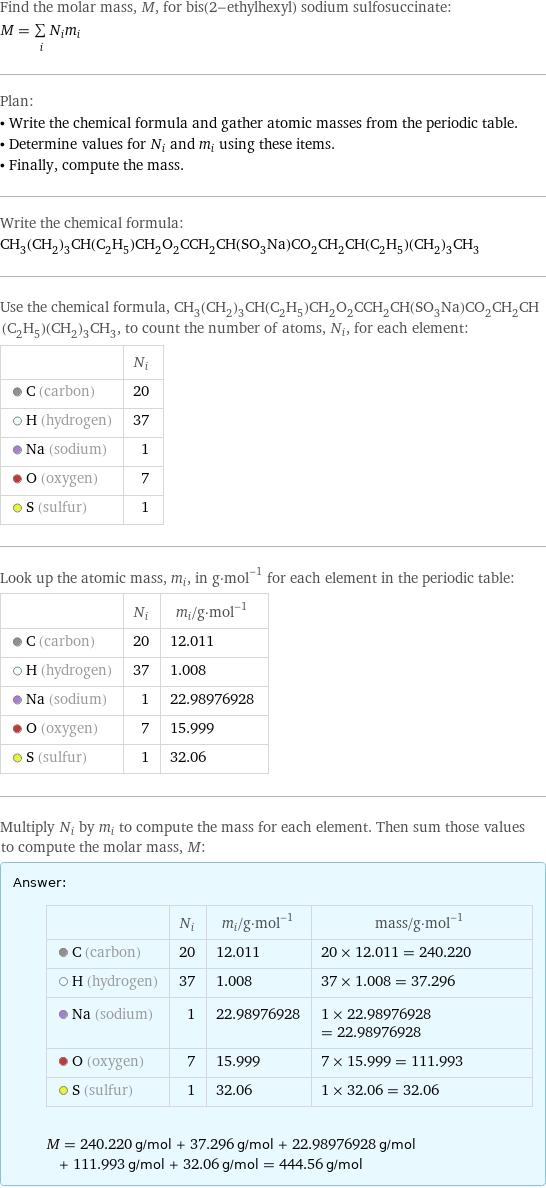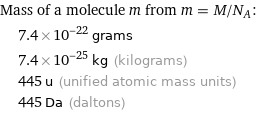Input interpretation

bis(2-ethylhexyl) sodium sulfosuccinate | molar mass
Result

Find the molar mass, M, for bis(2-ethylhexyl) sodium sulfosuccinate: M = sum _iN_im_i Plan: • Write the chemical formula and gather atomic masses from the periodic table. • Determine values for N_i and m_i using these items. • Finally, compute the mass. Write the chemical formula: CH_3(CH_2)_3CH(C_2H_5)CH_2O_2CCH_2CH(SO_3Na)CO_2CH_2CH(C_2H_5)(CH_2)_3CH_3 Use the chemical formula, CH_3(CH_2)_3CH(C_2H_5)CH_2O_2CCH_2CH(SO_3Na)CO_2CH_2CH(C_2H_5)(CH_2)_3CH_3, to count the number of atoms, N_i, for each element: | N_i C (carbon) | 20 H (hydrogen) | 37 Na (sodium) | 1 O (oxygen) | 7 S (sulfur) | 1 Look up the atomic mass, m_i, in g·mol^(-1) for each element in the periodic table: | N_i | m_i/g·mol^(-1) C (carbon) | 20 | 12.011 H (hydrogen) | 37 | 1.008 Na (sodium) | 1 | 22.98976928 O (oxygen) | 7 | 15.999 S (sulfur) | 1 | 32.06 Multiply N_i by m_i to compute the mass for each element. Then sum those values to compute the molar mass, M: Answer: | | | N_i | m_i/g·mol^(-1) | mass/g·mol^(-1) C (carbon) | 20 | 12.011 | 20 × 12.011 = 240.220 H (hydrogen) | 37 | 1.008 | 37 × 1.008 = 37.296 Na (sodium) | 1 | 22.98976928 | 1 × 22.98976928 = 22.98976928 O (oxygen) | 7 | 15.999 | 7 × 15.999 = 111.993 S (sulfur) | 1 | 32.06 | 1 × 32.06 = 32.06 M = 240.220 g/mol + 37.296 g/mol + 22.98976928 g/mol + 111.993 g/mol + 32.06 g/mol = 444.56 g/mol
Unit conversion

0.4446 kg/mol (kilograms per mole)
Comparisons

≈ 0.62 × molar mass of fullerene ( ≈ 721 g/mol )

≈ 2.3 × molar mass of caffeine ( ≈ 194 g/mol )

≈ 7.6 × molar mass of sodium chloride ( ≈ 58 g/mol )
Corresponding quantities

Mass of a molecule m from m = M/N_A: | 7.4×10^-22 grams | 7.4×10^-25 kg (kilograms) | 445 u (unified atomic mass units) | 445 Da (daltons)

Relative molecular mass M_r from M_r = M_u/M: | 445